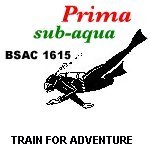
Issue 12 January 2008
Off-Gassing...
(Web Version)
Welcome to the first anniversary issue of our newsletter. Happy New Year!
Profile:- Al Noakes
Items for Sale:
10 litre Cylinder. In test
£50 contact: Richard Mace
0121 232 6007
-------------
Poseidon Cyclone regulator & Octopus (requires service) £50.
Also Poseidon Cyclone regulator & long hose (requires service) £50. see John Searle 07776 411406
--------------
If you have any items for sale please let us know.
Al Noakes code name "Tanglefooted One"
Advanced Diver, OWI with well over 2000 dives and 18 years experience. As a former Diving Officer, I have had the unique honour and privilege along with my wife and former Training Officer Lin, of leading Prima out of the old millennium and into the new.
I consider every dive a good one, if my buddy and myself surface within a couple of miles of the intended spot and no helicopters show up (I said that to save Paul the trouble).
My favourite diving is UK seas by far, as "Mother Nature" reveals her secrets in her own enchanting way, slowly, piece at a time, be it wreck or scenic. As precious as all these creations are to me, I am not afraid to say that "the Creator " is very much more so.
Finally, my ambition in diving is to see those I have taught, go further than me, by His grace.
The Presentation Evening / Dinner Dance
After a very enjoyable night (Pics on the Web Gallery) Ė Congratulations to the following:
George Babbington, Trainee of the year
Lin Noakes, Diver of the Year
Paul Waddell, Members Member
Tim Beech, Brass Ass.
Thank you to everyone for attending, and a big thanks to all those working behind the scenes to make it such a success, in particular, Lil and Geoff.
Animal of the Month
Editors Corner
Thank you to everyone who has contributed to this months issue, and apologies for any mistakes.
Any further articles for next months edition would be appreciated, (any gossip, scandals, etc thatís printable) so let us know by 28th january.
Hope you enjoyed this issue.
They are found
along the eastern coast of Australia from Lakes Entrance in Victoria to
North
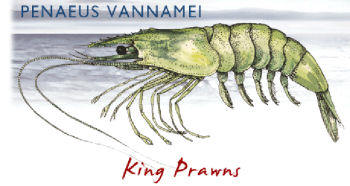 Reef
in Queensland. They are caught as juveniles in estuaries during spring
and summer and as adults on the Continental shelf at depths of 60 to 220
metres from mid-summer through to winter.
Reef
in Queensland. They are caught as juveniles in estuaries during spring
and summer and as adults on the Continental shelf at depths of 60 to 220
metres from mid-summer through to winter.
Normally male eastern king prawns grow to a length of 19cm and weight 110g, while the females can grow to 30cm and weigh 220g. Besides being smaller, males can be distinguished by a petasma (genital appendage) between the first pair of swimming legs. Females have a plate-like thelycum at the base of the last pair of walking legs.
They are caught by deep sea netting, or in estuaries by a hand-held net wielded by a wading person using a bright light to attract the juveniles. The light also reflects off their eyes, glowing red, so you can see them at night.
King Prawns
also known as Caribbean Prawn, or Pacific White Shrimp, a variety of
prawn
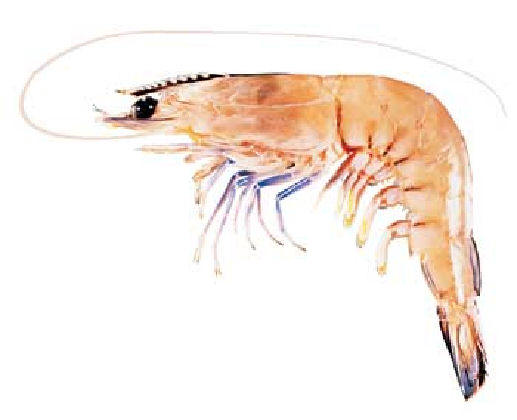 originating
from the eastern Pacific Ocean. They are among the most widely
cultivated shrimp in the world. This is due mainly to ease of
cultivation and rapid growth rate; harvesting begins after 120 days.
originating
from the eastern Pacific Ocean. They are among the most widely
cultivated shrimp in the world. This is due mainly to ease of
cultivation and rapid growth rate; harvesting begins after 120 days.
They can reach up to 23 cm, the body is translucent white, thus the
common name "white shrimp". The raw meat is white but turns whitish pink
when cooked.
It is the major species of farmed shrimp. King prawns are native to the
eastern Pacific, from Sonora in Mexico to northern Peru. The main
sources of Pacific white shrimp are Ecuador, Mexico and Brazil
Shipwrecks of North Wales, part 2.
In 1724 the Liverpool Harbour Corporation had taken a leading role in improving navigational safety of the North Wales coast. They authorised the use of 30lb of gunpowder to blow up some of the dangerous rocks between Anglesey and Puffin Island. In 1766 the Liverpool Corporation and port merchants shared the cost of promoting the Pilotage Act. The Act stated that Pilots should be used to navigate the entrance to Liverpool harbour. Pilotís stations were set up and Pilots guides with detailed maps and instructions published. Despite these measures the transatlantic traffic of the Industrial Revolution during the 1800s produced a peak of shipwrecks around the Welsh coastline. On the 25th October 1859 the ship Royal Charter, a 2,700 ton steam and sailing ship bound for Liverpool, was lost off Moelfre on the island of Anglesey. Almost at the end of its long voyage from Melbourne, Australia, the Royal Charter was carrying four hundred and fifty two passengers and crew and gold from the Australian goldfield valued at £320,000 and it sailed into the worst storm that had occured in the Irish Sea during the century.
After battling across the Irish
Sea, the captain called for the Liverpool pilot while off Point Lynas,
but the sea was too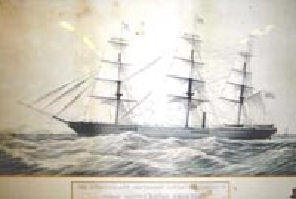 ferocious for the pilot to go aboard the Royal Charter. The captain was
faced either with the prospect of making his own way to Liverpool
without help, or sheltering from the severe weather in Moelfre Bay.
ferocious for the pilot to go aboard the Royal Charter. The captain was
faced either with the prospect of making his own way to Liverpool
without help, or sheltering from the severe weather in Moelfre Bay.
He chose to find shelter, but the ship's anchor chain broke under the strain and drove the Royal Charter stern first onto the rocks off Moelfre. The waves were so tumultuous that the ship struck the rocks fifty yards from the shore and broke into two sections. Every person on board was thrown into the sea except for thirty two who perished as they were hurled against the rocks. Many of the passengers were men returning from the Australian goldfields and some had attempted to leave the ship and swim to shore with their pockets filled with gold dust.
For weeks after the tragedy bodies were washed up on the beaches, and on the clifftop there is a memorial with the words "where the Royal Charter met its end, and the memory of those who died".
Wreck of the Month - Oceana
A Steamship P&O liner, 6610tons carrying 40
passengers, a crew of 210 and 3/4 million in gold and silver ingots,
sank following a collision with the Pisagua, on 16th March
1912. The Pisagua, a four-masted steel baroque and famous ocean-racer of
the German, Laeisz Line, in full sail, with the wind behind her,
travelling at 20 knots, she assumed that the Oceana would give way to
sail. Unfortunately the Oceana didnít see the Pisagua soon enough to
take evasive action and compounded that error by turning the wrong way.
Eight passengers and two crewmen died when a lifeboat capsized, the
cross-channel steamer Sussex safely took off the rest.
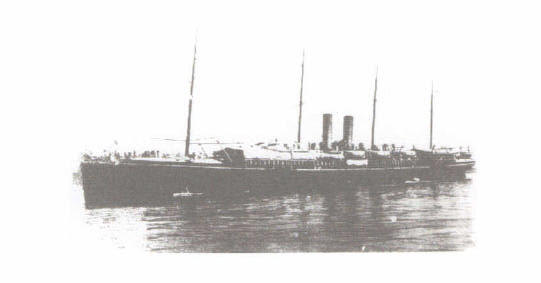
The Pisagua survived the incident and was taken to Dover for repairs. Hard hat divers were on the Oceana the following day, taking only 10 days to salvage the gold and silver. Ingots with a value of £3,000 were reportedly left behind and in 1996 a diver found one silver ingot.
Today she provides a nice dive lying 6.5 miles off Eastbourne in 22 - 27 metres. Apart from the Boilers, which stand 6 metres proud, she is fairly well broken but home to at least one impressive sized conger and on the day we visited lots of shoaling fish, large edible crabs and a monster lobster.
